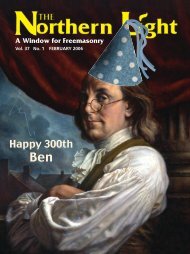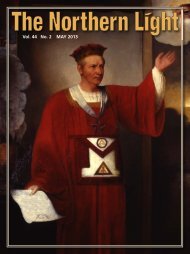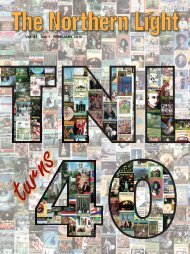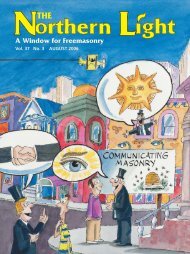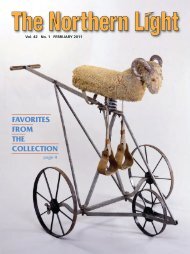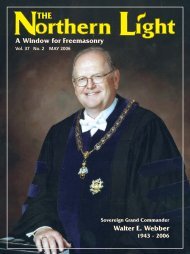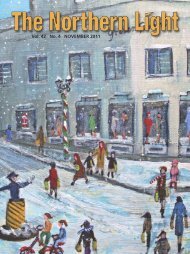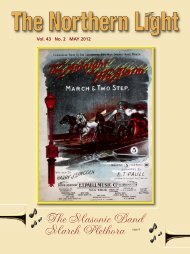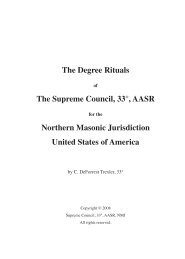February - Scottish Rite
February - Scottish Rite
February - Scottish Rite
Create successful ePaper yourself
Turn your PDF publications into a flip-book with our unique Google optimized e-Paper software.
without its accompanying note (see illustration).<br />
The note explains that the spike came<br />
from the frigate Constitution, one of the<br />
six original frigates authorized for construction<br />
by the Naval Act of 1794.<br />
Also known as “Old Ironsides,” the<br />
Constitution is the oldest commissioned<br />
ship afloat in the world and still makes<br />
brief voyages in Massachusetts Bay<br />
today.<br />
The ship was constructed between<br />
1794 and 1797, and Revere’s records<br />
show that he charged over $3,800 to<br />
outfit the vessel with copper fastenings.<br />
Undoubtedly, Revere’s experience<br />
with working silver and gold, selling<br />
imported hardware and running a<br />
foundry inspired him to pursue his<br />
greatest business venture.<br />
In 1800, at the age of 65, Revere<br />
started a mill in Canton, Massachusetts,<br />
for rolling sheet copper.<br />
Up to that point, Americans were dependent<br />
upon imported sheet copper<br />
from England.<br />
The primary use for this material at<br />
the time was protective plating on the<br />
bottom of ships. Copper inhibited marine<br />
growth that could damage and<br />
slow the ships.<br />
Sheet copper was also used on the<br />
roofs of public buildings. Revere<br />
wanted to be the first successful American<br />
producer of sheet copper; an ambition<br />
that he did realize.<br />
Using $25,000 of his own money<br />
along with $10,000 from the U.S. government,<br />
Revere purchased property<br />
on the Neponset River in Canton and<br />
started his enterprise.<br />
The Grand Lodge collection includes<br />
a model of the roller machine used to<br />
press the copper into smooth sheeting.<br />
By 1801, he was able to write to<br />
Robert Smith, secretary of the Navy, “I<br />
have erected my works and have rolled<br />
sheet copper which is approved of by<br />
the best judges as being equal to the<br />
best cold rolled copper.”<br />
One of his first orders was for 6,000<br />
feet of copper sheathing to cover the<br />
dome of the new State House.<br />
Soon after, Revere produced copper<br />
sheeting for the roof of St. Stephen’s<br />
Church. St. Stephen’s, located in<br />
Boston’s North End, was designed by<br />
Charles Bullfinch in 1802.<br />
Master Mason diploma for<br />
Joseph Walles Jr. designed by<br />
Paul Revere, issued by Warren<br />
Lodge in 1785.<br />
A fragment of this sheeting is currently<br />
in the Grand Lodge collection,<br />
along with four nails from the church<br />
that were supposedly made at Revere’s<br />
forge.<br />
The fragment of copper sheeting has<br />
remnants of gold paint or gold leaf on<br />
one side, a popular treatment for roof<br />
domes at the time.<br />
Despite decades of leadership within<br />
the Masonic bodies of Massachusetts,<br />
Revere significantly decreased his involvement<br />
after his term as Grand Master<br />
was completed in 1797.<br />
Unfortunately, there is little evidence<br />
to suggest why Revere stopped actively<br />
participating and failed to have a Masonic<br />
funeral when he died in 1818.<br />
Most likely his intense involvement<br />
with his copper rolling mill from 1800 to<br />
1811, requiring him to spend most of<br />
his time in the Canton countryside, impeded<br />
his ability to attend meetings.<br />
In 1811, Revere retired from active<br />
operation and management of his mill,<br />
giving control to his son.<br />
At that time, after eleven years in existence,<br />
the company was worth over<br />
$50,000.<br />
While Revere’s beautiful silver bowls<br />
and Masonic jewels are well known<br />
today it is the innocuous everyday<br />
items such as the diploma for Joseph<br />
Walles Jr., the spike from the frigate<br />
Constitution, and the fragment of copper<br />
sheeting from St. Stephen’s Church<br />
that help us understand the journey<br />
from artisan to gentleman that Revere<br />
made during his life.<br />
We are fortunate that Massachusetts<br />
Masons felt a connection with Revere<br />
and saved these relics, donating them to<br />
the Grand Lodge’s Museum collection.<br />
By thinking about the hands that<br />
crafted these materials, they allow us to<br />
learn about Revere’s contributions to<br />
Freemasonry and American history.<br />
If you own an object, engraving or<br />
certificate related to Paul Revere and<br />
would like to consider donating to the<br />
National Heritage Museum’s collection,<br />
please email Aimee Newell at<br />
anewell@monh.org or call 781-457-4144.<br />
A number of objects associated with<br />
Paul Revere will be part of the upcoming<br />
exhibition, “Sowing the Seeds of<br />
Liberty: Lexington and the American<br />
Revolution,” opening in April of 2007 at<br />
the National Heritage Museum in Lexington,<br />
MA.<br />
This new exhibition tells the story of<br />
how extraordinary patriots and everyday<br />
people shaped the course of the history<br />
of America.<br />
FEBRUARY 2007 / THE NORTHERN LIGHT 13




